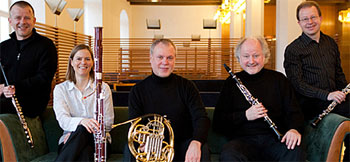 Chamber music is a burgeoning and vital aspect of musical preparation and performance. As the opportunities for wind players in chamber music increase, so does interest and expertise. “FIVE!” tm, the chamber music interview series of davidbrubeck.com is dedicated to elevating chamber music, particularly chamber music which involves woodwinds and brass. Launched with Windsync in January 2014, subsequent interviews from that same year from Dallas Brass, Canadian Brass, Seraph, and the Spanish Brass established the series. Thanks to the extraordinary kindness and generosity of these superb musicians, a valuable resource on the art and craft of chamber music was made available.
Chamber music is a burgeoning and vital aspect of musical preparation and performance. As the opportunities for wind players in chamber music increase, so does interest and expertise. “FIVE!” tm, the chamber music interview series of davidbrubeck.com is dedicated to elevating chamber music, particularly chamber music which involves woodwinds and brass. Launched with Windsync in January 2014, subsequent interviews from that same year from Dallas Brass, Canadian Brass, Seraph, and the Spanish Brass established the series. Thanks to the extraordinary kindness and generosity of these superb musicians, a valuable resource on the art and craft of chamber music was made available.
“FIVE!” tm really took off in 2015 with the incredible interviews listed below. From the iconic Empire Brass Quintet, to the amazing Berlin Philharmonic Woodwind Quintet; from the inspiring American Brass Quintet to the audacious Mnozil Brass, more and more of these amazing instrumentalists and skilled ensemble players have contributed what is now akin to a book on chamber music for winds and brass, all free of charge and universally available. We would like to express our deepest thanks to these individuals for their time, effort and expertise in assembling these interviews. It has been a blessed joy and delight to watch unfold.
We have selected a few of the most intriguing answers from each of the groups over the past year of 2015. Enjoy!
Berlin Philharmonic Woodwind Quintet
The blend in the group is extraordinary! The flute and the oboe in
unison (or octaves), create a completely new and consistent tone color. What
is your secret?
FM Intonation must be flawless, but more importantly we try to play “into” each other’s sounds. The Berlin Philharmonic strives for blend at all times and so do we; it’s our default setting. Choice of instruments also plays a role in the ability to blend. And listening to each other. We imagine playing “flut-inet”, “bass-orn”, “fl-oboe”, “fl-ob-inet” or “fl-oboe-horn” for example. 😉
MR The secret is that we purposely look for these new sounds and sound-mixtures.
It is both a challenge for us, and an irresistible temptation, (perhaps even the biggest difficulty), to discover new sounds.
Within the context of orchestral repertoire, woodwinds are more often
called upon as soloists than are brass players. How do you think that this
influences the basic approaches of brass quintets as opposed to woodwind
quintets?
FM The brass instruments are a homogeneous family, like the strings. The woodwinds are not – they are a collection of individualists. It is the woodwind section of an orchestra that is responsible for the “narration” in an orchestral performance. If we can say crassly that a brass quintet is basically a pair of trumpets accompanied by three lower instruments, then a wind quintet is a quartet of soloists held together by a horn.
Read the full interview here: Berlin Philharmonic Woodwind Quintet
The Meridian Arts Ensemble
4. How do you address note shape (the front AND the back of the note), when playing more rhythmic works?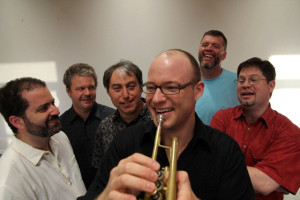
The MAE has a better group sense of rhythm than any ensemble I’ve ever played with. We listen closely to each other and imitate attacks and releases.
A lot of our matching each other comes from that listening, and much of the rest comes from our body language, which has developed over the course of our 25+ years. I would say that the listening and the body language account for 90% of how we evolve the shape of notes. The other 10% comes from talking, arguing, singing to each other. Sometimes it’s not really chamber music until you are arguing passionately.
I have learned over the years that my colleagues are always right. I may disagree with them, but their ideas are always good and true.
Read the full article here: Meridian Arts Ensemble
Ken Amis of the Empire Brass Quintet
3. What were the distinct aspects of the Empire Brass approach which separated them from other groups?
4. Which other brass groups have inspired you?
Philip Jones Brass Ensemble
Non brass?
A Ray Charles performance at Tanglewood in the mid-90’s.
5. What are your favorite EB recordings, and why?
Class Brass and Class Brass: Firedance are my favorite recordings due to repertoire and clarity and balance with which the playing was captured by the microphone placement and recording techniques.
Read the full interview here: Ron Barron and Ken Amis of the Empire Brass
Scott Hartmann of the Empire Brass Quintet
You can play really clean, or let it rip! How do you think of “hiding the slide”-(or its smears) when matching trumpets as opposed to your vibrant yet very rhythmic approach to glisses, scoops and falls?
Related to the previous comment on articulation, I have to imagine a sound first, then figure out how you make this sound on the trombone. Oftentimes, I find that people don’t feel that it is correct or appropriate to do something – mechanically or musically – so they restrict their musical palette in the process. I leave the door open to try to make any sound that comes to mind and use any technique that achieves it.
Technique is whatever I do in the process of making a sound. Again, if it sounds right – it is right!
So, a more succinct answer to your question. I think about the air, embouchure, tongue, slide, overtones, valve and how they interact as I make a sound.
strong>
 What are your favorite EB recorded tracks and why?
What are your favorite EB recorded tracks and why?
My favorite aspect of the EB is the level of chamber music that we enjoyed. When we knew the music, we could reinvent it on each performance; explore musical possibilities on the fly and let the music come to life each time we played. We would transcend our own voice and truly make music. This was amazing to be joined together through music this way, probably much like the bond that is created within a sports team or military unit…
I believe that our first Class Brass recording captured this ability – primarily because the acoustics at the recording were great and you can hear us using the hall the way we would in concert – most other recordings didn’t quite capture the hall acoustics.
I was Mr. Charlie Geyer’s graduate assistant at Northwestern and he really challenged me in my weak areas. We never really addressed any fundamentals – except for maybe his occasional opinion on things – and it really felt like a “finishing†school to help prepare me for the professional world. I always felt inspired and energized coming out of their lessons and I would regularly practice right after lessons to cement their teachings.
Read the entire interview here: Scott Hartmann of the Empire Brass
Axiom Brass
Three major things that I came away from the Barbara Butler/Charlie Geyer school were:
1) Attention to detail. I had gone to Navy boot camp and I thought I had a pretty good grasp of attention to detail, but they take it to the next level. Mr. Geyer often joked that he is undiagnosed OCD and said that “you have to be a little obsessed with the trumpet to be a good trumpet player.†Notations in the score, historical context, intonation, articulation, trumpet selection, mouthpiece selection, mute selection, tricks and cheats, you name it – if you’re trying to win a job against hundreds of other applicants, it can come down to a missed articulation or dynamic.
 2) Record everything you can. This isn’t a concept that is new or exclusive to their studio, but I haven’t seen a studio yet where it is so ingrained and, quite frankly, mandatory! Every lesson, every studio class, every audition (professional and mock), ensemble rehearsals, masterclasses were highly encouraged and politely expected to be recorded. Not only did Mr. Geyer want me to get my money’s worth for my degree, but I think there is concept from Arnold Jacobs of “you can’t sit in the performers’ chair and the teacher’s chair at the same time†that applies. Meaning that if you’re analyzing yourself while you’re performing, you won’t be very musical. Record, perform, and then analyze and scrutinize. This is a concept that is relevant to every Axiom Brass rehearsal and performance.
2) Record everything you can. This isn’t a concept that is new or exclusive to their studio, but I haven’t seen a studio yet where it is so ingrained and, quite frankly, mandatory! Every lesson, every studio class, every audition (professional and mock), ensemble rehearsals, masterclasses were highly encouraged and politely expected to be recorded. Not only did Mr. Geyer want me to get my money’s worth for my degree, but I think there is concept from Arnold Jacobs of “you can’t sit in the performers’ chair and the teacher’s chair at the same time†that applies. Meaning that if you’re analyzing yourself while you’re performing, you won’t be very musical. Record, perform, and then analyze and scrutinize. This is a concept that is relevant to every Axiom Brass rehearsal and performance.
3) The “power of the studio.†While I was at NU I tried to absorb as much as I could and I asked Mr. Geyer why he thought they had success with their students over the years. He said that obviously talent was a large part of it, but choosing the “right†students (in regards to attitude, good nature, and work ethic) is also a big part of it. He said that every once in a while they’ll get a “bad apple,†but the “power of the group†overcomes them and sets them straight. When you think about it, you don’t really spend that much time with your applied professor compared to your colleagues in the studio. In a year you might average 25-30 hours of private lessons, but you’re spending 25-30 hours a week with people in your studio.
One last contribution to my education I would be remiss without including would be Gail Williams’ (horn professor at Northwestern) “Teaching Techniques†class. It was a very simple concept – we had to observe 15 private lessons from various applied professors and write a small report on each one – but it made a lasting impression on me. While I believe that the trumpet is one of the best instruments of all time, I also think that we can learn so much from vocalists, strings, and woodwinds. Their instruments, when used by master composers as solo instruments, have a firm grasp of phrasing and musical nuance that I think is missing from nuts and bolts teaching of the trumpet.
Read the entire article here: Axiom Brass 2015
Mirari Brass
9. Where do you see the future of brass quintets heading in the next ten to twenty years?
We can’t speak for all brass quintets, but we think there will be many more chamber groups (not just brass quintets) popping up all over the country and world.
Chamber groups are a great vehicle to take music on the road, spreading the genre to a wide variety of people.
We also believe that live music will take on an even greater importance in the current age of Youtube and Spotify. In the past live music was a fundamental social event. Our society has somewhat moved away from that. We hope and believe that there will be a resurgence of that social importance, and as a result live chamber music.
Read the entire interview here: Mirari Brass 2015
The American Brass Quintet
What is a quintet warm-up like with the ABQ?
I have been in the ABQ for over 30 years, and there has never been a coordinated quintet warm-up. It sounds like a fine idea for a younger ensemble, however. Even when warming up independently in the same room, acceptable manners absolutely apply: Always be personally and musically polite regarding sound level, intonation, and your own passage-work connected with your warm-up. -MP
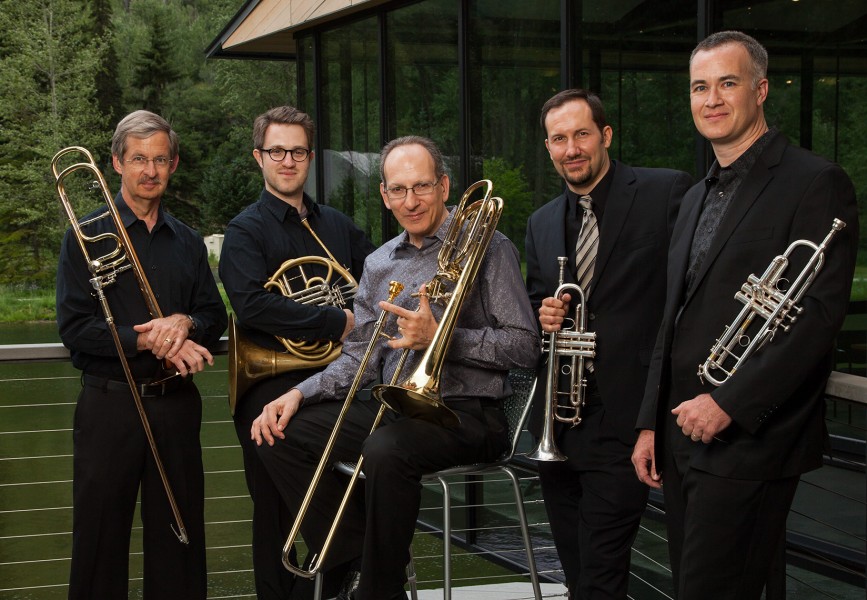
With the ABQ it is clearly all about the music, and yet the prominence of the bass trombone (certainly not to the exclusion of the tuba), often gives your ensemble a characteristic sound. How would you describe the ABQ relationship with the bass trombone, and what do you make of the trend for smaller tubas in other brass quintets?
The use of tuba in a brass quintet adds a nice roundness of sound, coupling with the conical French horn in a pleasing way. That said, it’s a bit like using a double bass in a string quartet instead of a cello; certain voicings and instrument ranges leave something to be desired in the middle of the spectrum. In the ABQ, the matching qualities of the two pairs of trumpets and trombones create a nice balance of sound timbre, which I think outweigh the sometimes deeper, rounder quality of a quintet with tuba. As for the popular use of smaller tubas in brass quintet, the often unfortunate trade-off for easier transport is a lack of full, round tuba sound mentioned above, and a wonky low-register, which begs the question, why use tuba after all? Nothing against tuba in brass quintet, it just presents more challenges, including overhead bins. We’re happy with the bass trombone for so many reasons. –ER
Read the full interview here: American Brass Quintet
Atlantic Brass Quintet
7. Your career evidences the most “dyed in the wool” brass quintet devotee. What do you see the brass quintet genre exploring in the next 40 years?
There is so much I could say about this…It would be my hope, that the brass quintet continually breaks musical ground to become a full platform for individual and group expression, outside of the general business idiom. The brass quintet can be, should be and is more than a gig band for graduations, weddings and ceremonial events. I believe more brass players will be composing, performing and recording their own pieces, hopefully with a personal emotional message to connect and share with their audiences.
I believe more multi-media works will be explored as well as brass quintet and electronics. It’s always been a dream of mine to have a brass quintet hooked up to a real time midi sequencer, with endless options for sound, not just a reverb/echo effect. I believe that we’ll see more collaborations with singers and other instrumentalists/ensembles which will expand the way we use/view the ensemble.
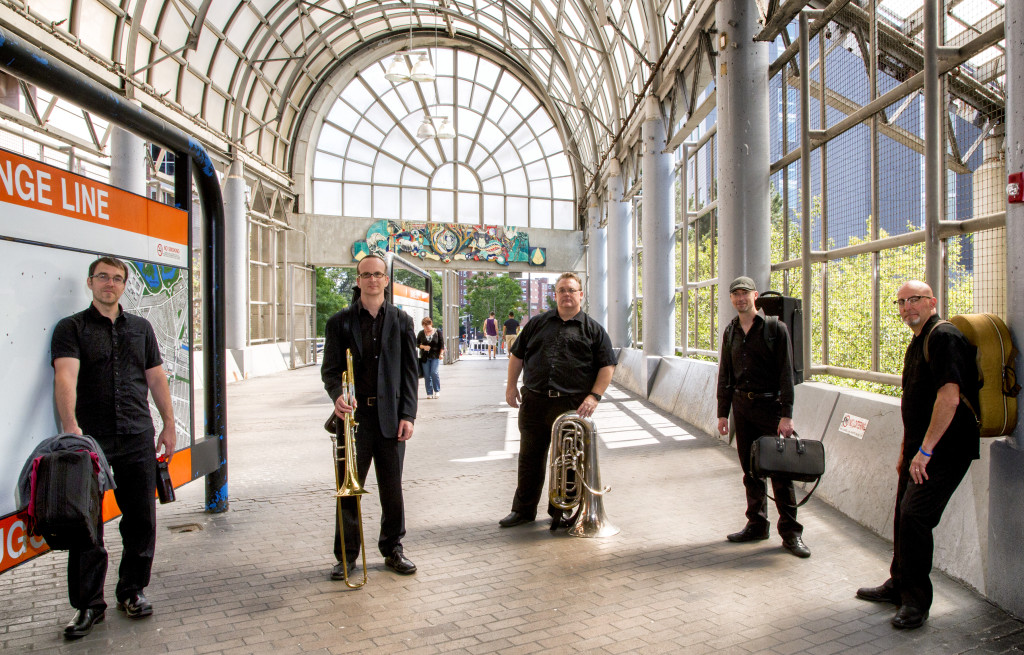 It seems unfortunate, at times, that the popularity of the brass quintet coincided with the that of contemporary music. As a result, many of the pieces actually written for brass quintet were not accessible to audiences’ ears-(and still aren’t!) This seriously hurt our future of being hired to play the music written for us by famous living composers. We need music that general audiences actually WANT to hear. This means the brass quintet needs great new music to play, that connects to audiences ears musically with a story to touch them emotionally. Therefore, the future of the brass quintet lies in the five individuals abilities to be great arrangers, composers and innovators, making sure that their end product, is something that has never been explored before.
It seems unfortunate, at times, that the popularity of the brass quintet coincided with the that of contemporary music. As a result, many of the pieces actually written for brass quintet were not accessible to audiences’ ears-(and still aren’t!) This seriously hurt our future of being hired to play the music written for us by famous living composers. We need music that general audiences actually WANT to hear. This means the brass quintet needs great new music to play, that connects to audiences ears musically with a story to touch them emotionally. Therefore, the future of the brass quintet lies in the five individuals abilities to be great arrangers, composers and innovators, making sure that their end product, is something that has never been explored before.
Read the entire interview here: Atlantic Brass 2015
Jeffrey Curnow of the Empire Brass Quintet
2. Could you discuss Rolf’s approach to the trumpet, and the types of trumpets (‘C’, ‘G’), he liked to play in different circumstances?
Rolf was the guy who made the Schilke ‘G’ piccolo trumpet famous. Before joining the band, I’d never played one (and I never played one while in the group), but the combination of his ‘G’ “picc.” and my ‘C’ trumpet created an interesting, distinctive hierarchy of sound that separated us from any other quintet.
This worked particularly well with Baroque and Renaissance lit. The set up he used on the G was different than usual. Schilke sent 2 bells with the trumpet, a small and a large, and he always used the large bell-which made the sound of the horn much bigger. That bigger “picc.” sound on top of the sound of a ‘C’ trumpet was a nice blend.
Outside of the Schilke ‘G’, Rolf used Bach/Selmer horns exclusively, and was feverishly adamant about it, in a way that only Rolf could be. Fortunately, I agreed with him completely on this issue.
Unlike most brass quintets, Rolf and I played C trumpet 80% of the time, using the Bb horns and flugels mostly for the crossover tunes on the second half. I think Rolf always felt more comfortable on a ‘C’ trumpet, as did I, and the sound of the ‘C’ trumpets gave the group a distinctive sound, separating us from other groups who exclusively used ‘Bb’ horns.
3. What was it like playing back and forth with Rolf with imitative passages as opposed to supporting him in harmony underneath; how did you match so well?
What was it like playing back and forth with Rolf? Intimidating is the word that comes to mind. When I joined the group, they were weeks from a U.S.S.R. tour so I had to hit the ground running. The blend wasn’t immediate but it had to happen quickly and I really worked at it. I wore 2 hats while playing 2nd, I had to be a bridge between Eric or Scott and Rolf and I had to fill Rolf’s shoes when he had the horn off his face. I found it really fun, honestly, and I wanted to be great at it. Rolf wasn’t much help so I was pretty much on my own when it came to figuring it out.
Read the entire interview here: Jeffrey Curnow of the Empire Brass
The Mnozil Brass
 1. “Applied Brass” is where the rubber hits the road. Please talk about your relationship with your audiences and how they may differ from those of traditional concert ensembles.
1. “Applied Brass” is where the rubber hits the road. Please talk about your relationship with your audiences and how they may differ from those of traditional concert ensembles.
Music is the most direct art form. You get back what you give immediately, but the relationship between musician and audience is defined by the player. I, for example, am always looking for eye contact with audience members. It encourages me to see peoples’ reactions to our show. With a brass instrument, it´s just great fun to use the whole dynamic scale and watch the audience reactions to that. You can make them cry, cheer, cover their ears or dance in their seats-it´s like telling stories. The difference for classical audiences is that they never know what´s going to happen in our show, and I think they like that!
2. The chemistry (or positive interactions) between the members of Mnozil Brass seems extraordinary. How did you meet? How do you keep it going ?
Wilfried, Gerhard and myself met around 1991 and started the group in the fall of 1992 together with some friends from the music university. In the beginning, we were playing mostly as a quintet. The septet line up happened in 96; that was also the time when the group got more “professional”.
in 2001 we did our first show with a director and choreographer. As you can see, everything developed very slowly and maybe that is one of the main reasons why we´re still having fun. There was never a “hype” about us; everything developed very naturally. As a matter of fact, we had already had made a living with the group for some years, before the media in Austria discovered us. Everything happened within the brass community, and by the time we became known to a wider public, we had already worked together for about 13 or 14 years.
3. “See our Music”, your additions to brass presentations go way beyond the traditions of simple blocking, and even beyond choreography. It is Theatre! How did you arrive at this amazing break-through of presenting bras concert music as theatre?
We achieved this by working with an actor/director named Bernd Jeschek, who had come to us after seeing one of our early, very wild performances. Our first shows were very free: a set list and a lot of “improv” on stage-some good, some bad. The main problem was our lack of timing. Seven jokes at a time; he showed us that less was more.
Read the entire interview here: Mnozil Brass 2015
Sam Pilafian of the Boston Brass and formerly, of the Empire Brass
 1. How do you approach playing in a touring brass quintet differently with Boston Brass as opposed to when you toured with Empire?
1. How do you approach playing in a touring brass quintet differently with Boston Brass as opposed to when you toured with Empire?
(hahaha)…This is very much a Rip Van Winkle story!!
(“Back in the Pre-Digital Day” with Empire we will call THEN…
I will refer to today’s Boston Brass as NOW :)) :
-THEN:We carried an extra suitcase with “safety music”.
-NOW: we all carry everyone’s parts and scores on laptops, iPads and even smart phones.
-THEN: I went to find a pay phone or a fax machine every time we stopped moving (on a plane or automobile), to check in with the manager, sponsor of the impending concert, family, etc.
-NOW: communication is in my pocket at all times…(Only Dick Tracy and Flash Gordon had this in Empire days!!)… I can fax, email, talk, text, send documents, photos, graphics, etc. from my phone or another digital device!
-THEN: Travel outside the US presented a myriad of communication and financial problems: expensive telephone calls and often daily currency changes-prior to the Euro. Using a credit card was dangerously insecure and subject to up charges by vendors who were waiting for currency rates to go in their favor before processing your transaction.
-NOW: Internet communication allows all of the above-listed activities to be done for free with a Wi-Fi or hard-wired signal. Financial issues are now guaranteed safe with stable rates by using major credit cards!
-THEN: Arranging, a major responsibility of mine in Empire, was also pre-digital. I learned to write and copy parts on a clipboard “floating” on my left forearm and hand while riding in planes, cars, ferries, etc. We often had part copying pizza parties in my room while on tour! (One time we got on a flight from Zurich to NYC with the count Basie Band and we all copied 2 new Frank Foster arrangements and visited…(I miss the social aspect of music copying but hated how slow the process was:)) Whole concerts and recording projects were arranged on the move in this manner for over 20 years!
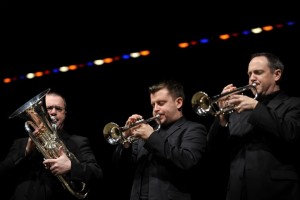 -NOW: Boston Brass has THREE arranger/ composers
-NOW: Boston Brass has THREE arranger/ composers
(José, Chris and me). Digital technology in the writing area is one of the great improvements between then and now!!! The speed, instant playback, orchestrated sounds and legibility have changed our lives for ever! I love traveling with my writing colleagues! It’s like an arts colony around Boston Brass these days!!!
-THEN: LP/Cassette/CD recordings and radio production recordings(common outside the US),were recorded and finished (or edited and mastered) by flying to the city where the recording company headquarters was located. I often made several ” post recording” trips to represent The Empire Brass during editing or mastering.
-NOW: Live concert videos and audio are easily made on tour …either self-made or in collaboration with the concert presenter. “Home” equipment is so good that the group may have more hits from YouTube or other Internet services than we ever got from the very well-selling studio Empire recordings. “Post recording”, for studio recording sessions, is done anywhere from cloud based data sent to our digital Internet devices. One only needs professional quality headphones to make critical decisions anywhere! Another strong difference in the present experience is that both José and Domingo are also professional recording engineers. I am a professional audio recording producer and video line producer. We have people from the media business in the group!!!
-THEN: I did the business work of Empire as well, (contracts, travel scheduling with an agency, payroll, taxes, etc)…
It was much better to do this when arriving home from tour while surrounded by “business machines” like fax,copy machine, type writer, postal meter,etc. This would routinely take more than a whole day upon returning home.
-NOW: Just about 100% of the business is done digitally, (very little mail or express services). All the business devices are available on any Internet device that we are carrying, including the 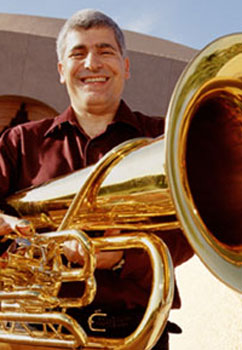 smartphones in our pockets. I am amazed how fluidly Jeff Conner runs most of our business, and Domingo leads the social media/ PR/ advertising campaign….while on the move. My, My…how times have changed!!!
smartphones in our pockets. I am amazed how fluidly Jeff Conner runs most of our business, and Domingo leads the social media/ PR/ advertising campaign….while on the move. My, My…how times have changed!!!
FINALLY, the biggest difference between the Empire and Boston experience is the amazing diversity of the present Boston Brass. They are well-equipped to authentically present improvised jazz and world musics (from throughout their personal experiences and histories) while at the at the same time present concerts at which they are playing wonderfully in the classical tradition. This depth of the diversity in addition to the fact that we are a truly multi-generational ensemble with over a 30-year spread in ages makes our rehearsals, performances and recording sessions very special. I feel like I trained for this diverse moment my whole life. (Kudos to Chris Castellanos, who did the same on horn, making him Extremely rare and valuable to the present efforts of Boston Brass:))
I am so fortunate to have another world class experience in the same career area! Again!!!
Read the entire interview here: Boston Brass 2015
c. 2015 David William Brubeck All Rights Reserved www.davidbrubeck.com
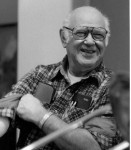 For brass, the beginnings of modern chamber music emerged in Chicago with the Chicago Symphony Brass Quintet and its founders, Adolpoh “Bud” Herseth & Vincent Chicowicz (trumpets), Richard Oldberg (horn), Frank Crisafulli (trombone) and Arnold Jacobs (tuba). “FIVE!” tm 2015 is dedicated to Frank Crisafulli.
For brass, the beginnings of modern chamber music emerged in Chicago with the Chicago Symphony Brass Quintet and its founders, Adolpoh “Bud” Herseth & Vincent Chicowicz (trumpets), Richard Oldberg (horn), Frank Crisafulli (trombone) and Arnold Jacobs (tuba). “FIVE!” tm 2015 is dedicated to Frank Crisafulli.
Interested in more “FIVE” tm interviews?
Canadian Brass 2014, Windsync 2014, Boston Brass 2015, Mnozil Brass 2015, Spanish Brass 2014, Dallas Brass 2014, Seraph 2014, Atlantic Brass Quintet 2015, Mirari Brass 2015, Axiom Brass 2015, Scott Hartmann of the Empire Brass 2015, Jeffrey Curnow of the Empire Brass 2015, Ron Barron and Ken Amis of the Empire Brass, Meridian Arts Ensemble 2015, Berlin Philharmonic Woodwind Quintet 2015, American Brass Quintet 2015



